Top 5 Order Management Systems in 2025
- What is Order Management?
- What is an Order Management System?
- Type of Order Management Systems
- How Does an Order Management System Work?
- Why is an Order Management System Important for Your eCommerce Business?
- eCommerce Order Management Challenges
- 5 Order Management Software Your Business Needs
- How to Choose the Right Order Management System?
- Shiprocket: A Comprehensive Shipping and Order Management Solution
When you run an eCommerce business, the orders you receive are the epicenters for generating revenue! Hence, you cannot afford to miss out on even one of the incoming orders on your eCommerce website or marketplace. When you are starting, it is alright to manage incoming orders manually. But once you begin receiving around 50 orders a day, it gets difficult to manually keep track of the SKUs and quantities of each order. This is where order management comes into play! Let’s dig deeper to understand this aspect of the order fulfillment chain and learn about order management systems (OMS) that make this process easier for you.
To understand the various OMS available in the market, we first need to begin with the basics. Let’s start with what order management is and how it is useful for eCommerce business.

What is Order Management?
Order management refers to the process of receiving, tallying, and processing orders that come in on your eCommerce website or marketplace. The typical process includes receiving an order from a customer, cross-checking, and updating the inventory, followed by assigning the order to the warehouse and ultimately processing it by packing and shipping it.
You can carry out these steps manually or by using an order management system(OMS) that can automate the process for you.
What is an Order Management System?
An order management system is online software that helps you manage your orders by keeping in sync with your inventory. It lets you streamline your order management process by automating the workflow and reducing manual work.
Type of Order Management Systems
Let’s explore the most common types of order management systems.
Cloud-based & On-Premise Systems
OMS can be deployed as onsite software or as SaaS or cloud models. Cloud-based models offer a lot of benefits over on-premise systems. They provide easier and quicker deployment and enable you to access it from anywhere with an internet connection and a mobile app or browser. You also get the flexible option of ‘pay as your business grows’ for enhanced scalability. Since the vendor will maintain the host application, you’ll also get a superior user experience with high reliability.
Individual and Enterprise Systems
You can opt for an individual module of OMS if you don’t want to integrate it with other aspects of your business. However, a robust enterprise OMS can integrate with other software so all your data is in a centralised, digital location. For instance, data from your order management systems will be integrated with finance, supply chain, customer relationship management, inventory management, and other business operations. This facilitates greater automation functionalities and comprehensive reporting, giving you an idea of how different aspects of your order management process affect your profitability in the long run.
How Does an Order Management System Work?
To effectively handle eCommerce orders, the focus should be refining the order routing and fulfillment process while minimising errors. Delving into the essential steps of a typical order process and its associated challenges provides valuable insights.
Here’s how an order management system can help you streamline different aspects of the order management process.
1. Order Placement:
The initiation point is where customers place orders, either through your website or a third-party platform. The business then logs and accepts the purchase order, employing manual methods or leveraging order management software. Subsequently, a confirmation email is dispatched to customers, encompassing order details and payment confirmation.
2. Inventory Management:
A pivotal process involving monitoring, tracking, and controlling product inventory to prevent stockouts or overstock situations. Integrating inventory systems with order management ensures accurate product availability. Real-time tracking aids in streamlining the supply chain, reducing storage costs, and enhancing cash flow.
You can use an order management system to collect historical data and use it later to manage your inventory better. It also enables you to generate reports on trends and seasonality, which can help you forecast demand more accurately. By analysing this data, you can make more informed decisions regarding how much stock to reorder based on past sales and expected demand.
You would want to avoid overstocking as it can lead to higher carrying costs, storing costs, and even dead stock. Contrarily, understocking would increase the risk of running out of stock, missing out on sales opportunities, and dissatisfied customers. An OMS can help you optimise inventory, so you can meet customer demand and keep costs low at the same time.
You can analyse data even further, identify which SKUs are generating the most demand in a particular location, and decide where you’ll store inventory if you use more than one warehouse.
3. Order Processing & Tracking:
The backbone of operations encompasses verifying and validating orders, authorisation of payments, and preparation of items for shipment. Automating order processing through integrated systems eliminates manual data entry and reduces processing time. Real-time order tracking capabilities add transparency and facilitate customer inquiries.
An OMS can help you track orders and shipments at every stage, from processing to delivery. Order tracking is essential for your business; today’s customers also want to track their orders in real time. As many as 90% of customers actively track their packages online, with most of them tracking their orders multiple times a day. Enabling your customers to track their orders in real-time will reduce the number of inquiries related to delivery status and build brand loyalty. Your team can spend more time on other important tasks and issues.
An OMS automatically updates the order status. You can share the order tracking information, including shipping updates, status, estimated arrival time, etc., with your customers.
4. Fulfillment and Shipping:
Fulfillment involves the critical processes of picking items from inventory, securely packaging them, and coordinating with shipping partners for timely delivery. Streamlining fulfillment is achieved through an efficient order management system, integrating with inventory and shipping systems. Multiple shipping options and clear communication on estimated delivery times enhance customer satisfaction.
With an OMS, you can fulfill orders faster and more accurately. Most order management systems work in two-way sync to make sure all information is shared between the OMS and your eCommerce platform and/or fulfillment software. You can ensure all items are quickly picked, packed, and shipped with a warehouse management system. When data is simultaneously updated across all platforms, it gives you more visibility into the entire shipping process.
5. Customer Communication:
Customer communication includes providing timely customer updates at various stages, including order confirmations, shipment notifications, and delivery tracking details. Implementing automated order confirmation emails and notifications ensures clear and concise communication. Self-service options like online order tracking portals and dedicated customer support channels facilitate prompt responses.
6. Returns Management:
Returns are an inevitable part of any eCommerce business. Not all orders will end up with your customer. The average return rate for eCommerce orders is typically 20% to 30%. That’s why tracking orders that are sent back is equally important.
An order management system can help you manage returns by tracking return rates and why they were returned. It also collects data to help you improve product quality and reduce returns in the future. Eventually, you can streamline the return process to improve customer satisfaction so they continue purchasing from your brand in the future.
Why is an Order Management System Important for Your eCommerce Business?
Many reasons make an order management system essential for the smooth functioning of your business. Let’s have a look at some of them:
- Streamline Fulfillment Process: An order management system helps you streamline your order fulfillment process by aligning all activities in a unidirectional flow. It establishes a uniform format for order processing that eliminates all doubts around re-checks. It allows you to send orders for packing and ship them faster.
- Reduces Errors: With automated order management, you don’t have to keep track of incoming orders in an Excel sheet manually. The OMS directly fetches data from your website and inventory to give you a holistic view of your current incoming, processed, and pending orders.
- Saves Time: Though not all, most OMS receive and automatically verify customer orders. They even directly enter them into your order processing system (or ERP if you’re a large enterprise), so you don’t have to repeatedly re-enter all information like order details, delivery information, etc. Order management systems reduce manual work, from processing orders to recording historical data. You can easily pull a customer’s purchase history and use the data to identify sales trends and forecast future demand.
- Faster Order Processing: A streamlined process helps you eliminate unnecessary steps like list maintenance and checking to send out orders to the warehouse and then process them. You can save 24-36 hours with an automated process that alerts your warehouse as soon as a new order comes in. Otherwise, you will send a consolidated list at the end of the day, and the orders will begin processing a day later.
- Single View For Multiple Channels: If you sell on multiple channels like Amazon, eBay, Shopify, Bigcommerce, etc.you can easily integrate all channels into one and process orders as one unit. This helps you keep a single view across all channels, and the quantity is directly reduced from a master inventory. This avoids confusion, and you can remove listing out of stock products faster.
- Constant Inventory Sync: Continuous inventory sync in the background can remove the doubts around creating multiple orders, incorrect SKU details, product mismatch, etc. It also helps you manage your inventory in a more organized manner. If you use an inventory management software that also contains an OMS, your business can thrive better in this market.
- Accurate Reporting: Since OMS tracks the entire process, from receiving an order to delivering it to your customers, it makes reporting easier and more accurate. Reports are updated in real-time, reducing the risk of errors and saving you time.
eCommerce Order Management Challenges
E-commerce order management demands careful consideration to maintain a robust online presence for your business. When selecting an eCommerce order management system, it’s crucial to be mindful of the following challenges mentioned below:
- Data Gaps and Inconsistencies: The risk of data gaps and inconsistencies grows as your eCommerce business expands across markets and channels. Mistakes and inconsistencies stemming from human errors and inconsistent logic can lead to issues such as order cancellations and a compromised customer experience. Identifying and resolving these data gaps is crucial, requiring analytics tools for improved system performance and heightened customer satisfaction.
- Syncing Inefficiencies: Effective communication is vital when users from diverse locations access your order management system. Inaccurate bi-directional data syncing, including product inventory, pricing, and discounts, poses a risk to operational efficiency. Slow or erroneous syncing can result in errors affecting shipping and ordering, impacting operational costs. Addressing this challenge requires a robust tech foundation for bi-directional syncing. This ensures accurate and timely data transmission.
- Insufficient or Redundant Features: While order management systems have established best practices, challenges arise when essential features are missing, or redundant ones complicate processes. Integrating external tools or plugins may be necessary, but doing so should be a thoughtful process. Unnecessary features can add complexity and costs without delivering tangible value. Achieving a balance involves integrating external tools only when necessary to streamline the order management process.
- Difficulties with Bulk and Multi-Package Orders: Bulk and multi-package orders are integral to business growth, but not all order management systems handle them seamlessly. Systems that overlook these complexities may necessitate manual handling, leading to challenges, especially with refund policies. Overcoming this involves selecting a system capable of efficiently processing and fulfilling bulk and multi-package orders, reducing errors, and ensuring customer satisfaction.
- Limited Customisability: While order management systems provide standardisation, businesses often require customisation to align with specific models and customer expectations. The challenge arises when these platforms offer limited personalisation. Striking a balance between standardisation and customisability is essential. Opting for a system that allows tailored adjustments based on your business model ensures flexibility without compromising the foundational benefits of order management standardisation.
- Incomplete Integration with External Tools: In today’s omnichannel business landscape, seamless integration with external tools is crucial for expanding across different channels. Incomplete integration or incompatibility can negatively impact the omnichannel experience for customers and the company’s operations. Overcoming this challenge involves selecting an order management system that seamlessly integrates with external tools, ensuring a cohesive and streamlined omnichannel experience.
- Poor Service and Support: Beyond software challenges, ineffective backend service and support can hinder the use of an order management system. This is particularly critical at the enterprise level, where integration with existing CRM and ERP modules may be intricate. The lack of responsive technical support can turn a functional solution into a hindrance, affecting the overall profitability of the business. Addressing this challenge requires prioritising a solution with reliable service and support.
- Difficulty Managing Multiple Sales Channels: Processing orders across various channels introduces complexity and potential delays. Managing multiple touchpoints increases the risk of errors, impacting your control over the business. Implementing strategies to handle orders from different sales channels efficiently is necessary. Streamlining processes and adopting technologies that unify order management across diverse channels can help maintain control and enhance efficiency.
- Frequent Inventory Shortages: Without an effective online order management system, your business has the risk of falling behind due to sudden inventory shortages. Managing inventory becomes increasingly challenging as your business expands. Investing in a robust order management system with efficient inventory management features is crucial to address this. This ensures real-time visibility into stock levels, minimising the risk of stockouts and enabling your business to fulfill orders promptly.
- Scattered and Hard-to-Manage Information and Data: Many businesses initially rely on multiple systems to handle orders, leading to scattered information. Simplifying operations by transitioning to a unified order management system is crucial. This integration reduces complexity, streamlines data management, and provides a centralised platform for overseeing all aspects of order processing.
- Buyer-Friendly System: As customer expectations rise, ensuring your user-friendly order management system becomes crucial. B2B customers expect transparency regarding order status and immediate responses to queries. Confidence in the availability and timely delivery of purchased products is paramount. To meet these expectations, prioritising an order management system that provides clear communication, real-time tracking, and responsive customer support is essential. Building trust with customers enhances their overall experience, fostering loyalty and satisfaction.
5 Order Management Software Your Business Needs
If you’re looking for an all-in-one solution that enhances efficiency and integrates seamlessly with your existing workflows, here is a list of order management software that can help you:
NetSuite
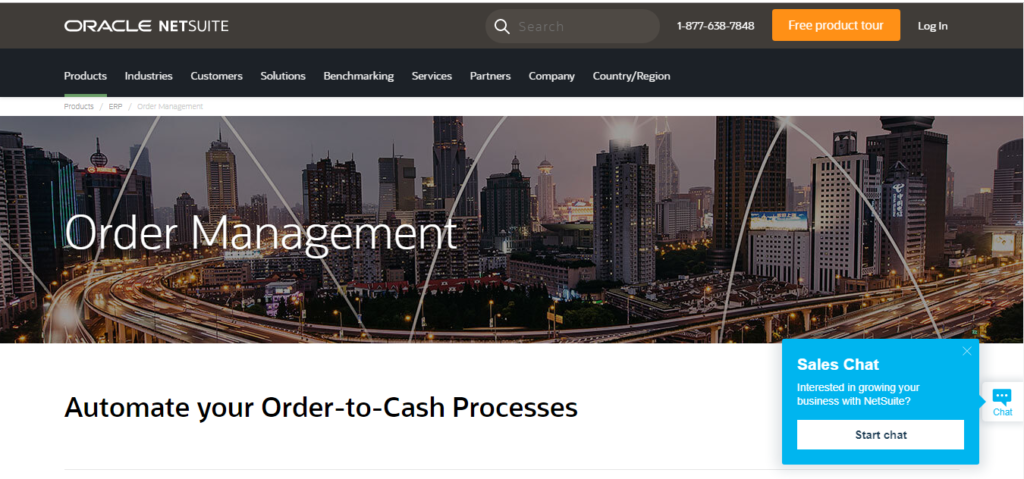
NetSuite is Oracle’s Inventory and order management system designed specifically for eCommerce businesses. It is a cloud-based order management solution that is efficient and makes the task of order management extremely easy for you.
Here are a few salient features of NetSuite’s order management software that can help you run your business smoothly –
- Real-time visibility of inventory
- Analytics around inventory, including trends, stock availability, etc.
- Billing management & invoice generation
- Sales Order Management
- Returns Management
ZOHO
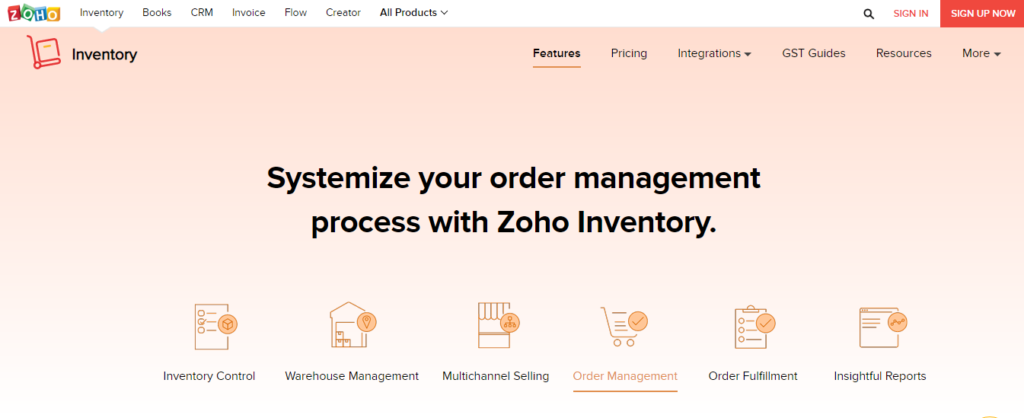
ZOHO is a cloud-based inventory and order management solution that is suitable for managing your orders across multiple channels. Also, it is one of the best software to control your incoming orders and process them at ease efficiently.
Here are few of ZOHO’s offerings to make sure your business aligns with the product –
- Integration with multiple sales channels like Amazon, eBay, Shopify, etc.
- Centralized order management system
- Label generation
- Payment integration
- Order tracking
Veeqo
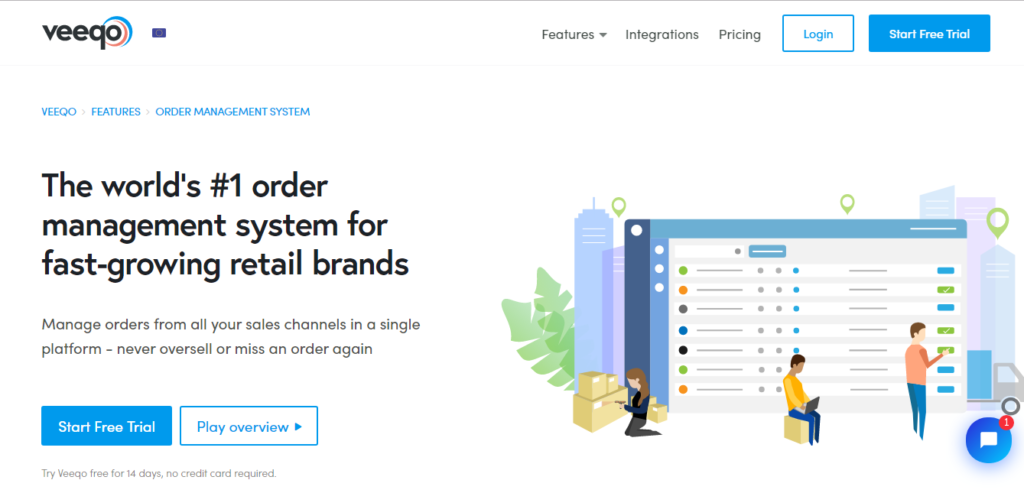
Veeqo is known for its software’s performance with leading retail brands. Their order management system is robust and offers you many features to make order management a simplified task for your business.
These are a few features offered by Veeqo –
- Integrated warehouse management
- Omnichannel selling with the integration of physical and online stores
- Manage accounts with an integrated inventory, and sales channels
- Single view for all purchase orders
- Cloud-based solution
TradeGecko
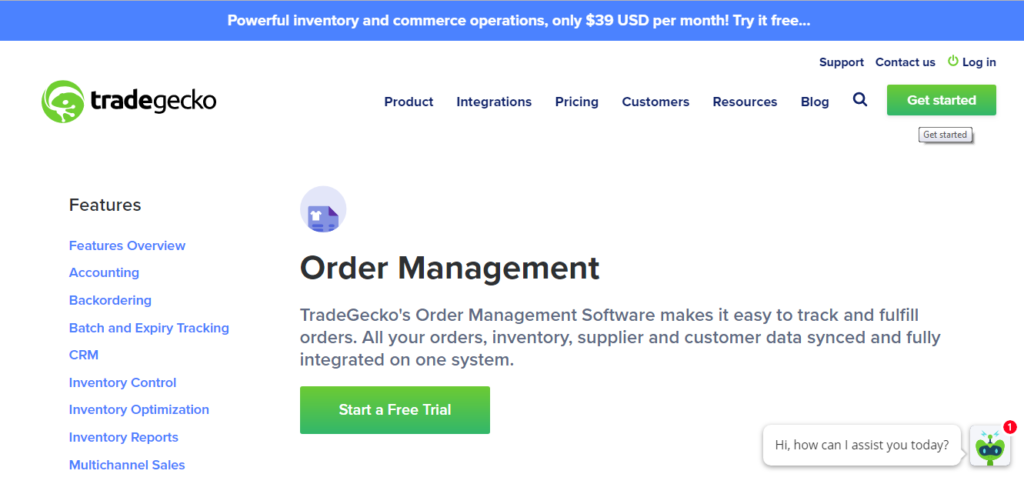
TradeGecko is a comprehensive inventory and order management system designed to help you sell better. All data ranging from customer data, warehouse, and inventory are synced successfully on one platform.
Here are a few characteristics of their OMS –
- Order management across multiple channels
- Detailed reports and insights about orders, customer insights, demand forecasting, etc.
- Wholesale order management
- Inventory forecasting
Salesorder.com
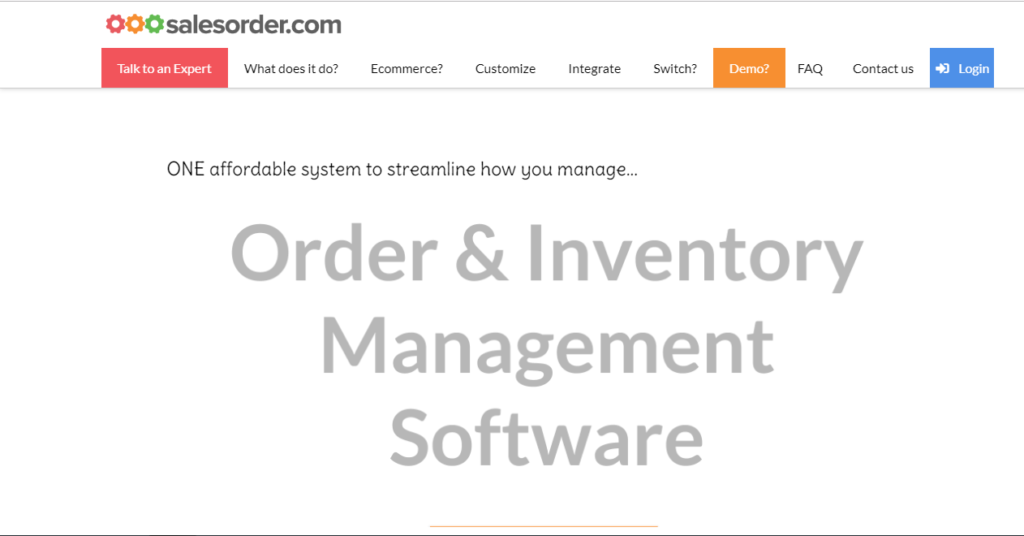
Salesorder.com is also a similar order management system aimed to streamline your order management processes. It deals with inventory and order management to provide you with software that can integrate all aspects into one.
A few features of the Salesorder.com OMS include –
- Order allocation and stock management
- Order capturing
- Caters to stock & ship, dropshipping, manufacture & ship, and assemble & ship businesses.
- Multiple channel order processing
- One view for all orders
How to Choose the Right Order Management System?
Here are some factors you should consider before choosing an order management system.
- Assess Your Business Needs: Analyse your business’s current and future requirements in terms of growth, increased order volumes, multiple sales channels, and global expansion. If you’re switching to a different OMS, identify your pain points and define your objectives. Research potential OMS providers, select a few based on your needs, check their track record, and review their industry reputation before making a decision.
- Look for Essential Features: A good order management system should offer all the necessary features, including inventory management, order tracking, multichannel integration, automation, returns and refunds management, and data analytics and reporting. You can request demos and trials to get hands-on experience with the OMS to evaluate its usability and functionalities.
- Flexible & Scalable: The order management system you choose should be flexible in terms of customisability, etc., and scalable. It means it should be able to accommodate your business’s growth and increase order volumes without any limitations in the future.
- Integrations: It should enable seamless integration with other software, such as CRM, payment gateways, ERP, eCommerce platforms, and different sales channels.
- User Experience: Before choosing an order management system make sure you check its user interface, whether it’s intuitive, user-friendly, etc. For a superior user experience, it should be designed to facilitate easy navigation and efficient order processing by your team. You can read reviews online or take advantage of free trials if the OMS provider offers it.
- Customer Support: Ensure the OMS vendor offers reliable customer and technical support for resolving issues promptly and adequate training for smooth onboarding.
- Cost Structure: Analyse the initial setup cost, recurring fees, potential return on investment, and whether the amount justifies the features and functionalities offered. Inquire about any hidden charges to avoid surprises in the future.
Shiprocket: A Comprehensive Shipping and Order Management Solution
If you’re looking for an order management solution that can directly let you ship through multiple courier partners, you can utilize Shiprocket’s services. Shiprocket offers you shipping to over 24000+ pin codes in India and 220+ countries & territories abroad, with 25+ courier partners.
Along with this, all your orders are synced with the platform, and you get auto-generated labels once you begin processing. Not just this, there are many more features that you can use for seamless order fulfillment. Sign up today to find out yourself!







Thanks for sharing valuable information, It is useful and informative